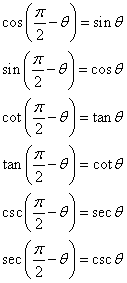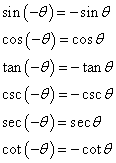Deriving sin(x+y)
Wednesday, December 15, 2010
Double Angle Identities
Double angle identities involve reducing the trigonometric function of a doubled angle (2x, for example) and expressing it in terms of its single component (in this example, x). To do this we must first know the sum formula identities:



Since
 ,
, we can use the sum formula identities to derive a double angle identity.
















Here is the derivation for the double angle identity for sine:



Here is the derivation for the double angle identity for tangent:



And finally, the derivation for the double angle identity for cosine. This one is the trickiest because it has three possible derivations that can be used in different situations.
Here is the first of the three derivations:



From here, we can derive two more equivalent identities using the Pythagorean Identities to derive two more:
Version 1 (cosine only):



Version 2 (sine only):



Here is a picture of all the double angle identities together:

Important things to remember:
- trig(2x)=/= 2trig(x)
- There are three derivations for cos(2x)
In loving memory of John D. Enison
Power Reducing & Half Angle Formulas
Today, we learned the power-reducing formulas which can be derived from the double-angle formulas.

We also learned about half-angle formulas, which you can derive from the power-reducing formulas by replacing  with u/2
with u/2
 with u/2
with u/2Sum to Product Formulas
 Product to Sum Formula
Product to Sum Formula
These are really tricky but most of it you just plug in the angles and come up with the solution.
Monday, December 6, 2010
Squaring Trigonometric Functions
Squaring Trigonometric Functions- Emily Smith
In class today we learned about squaring trigonometric functions. This is another way to help people solve identities. When two different trigonometry functions are on either side of the equation and you cannot use a Pythagorean identity, you cannot factor, and changing it into sin and cos doesn’t help, you must square both sides of the equation.
Example:
cosx+1= sinx <-- you cannot use a Pythagorean identity or factor so you must square both sides
(cosx+1)2=(sinx)2
(cosx+1)(cosx+1)=sin2x
cos2x+cosx+cosx+1=sin2x
cos2x+2cosx+1=sin2x
cos2x+2cosx+1=1-cos2x
+cos2x +cos2x
________________________
2cos2x+2cosx+1=1
-1 -1
________________________
2cos2x+2cosx=0
2cosx(cosx+1)=0
2cosx=0
x=π/2,3π/2
cosx+1=0
-1 -1
x=π
***** Because you squared the equation you must check for extraneous solutions. You must plug π/2,3π/2, and π in for x and make sure that the equations are equal.
In this problem when you plug the solutions in for x 3π/2 does not work.
There are two times that you must check for extraneous solutions…
1. Squaring equations
2. Fractions such as tan where it is sin/cos
In class today we learned about squaring trigonometric functions. This is another way to help people solve identities. When two different trigonometry functions are on either side of the equation and you cannot use a Pythagorean identity, you cannot factor, and changing it into sin and cos doesn’t help, you must square both sides of the equation.
Example:
cosx+1= sinx <-- you cannot use a Pythagorean identity or factor so you must square both sides
(cosx+1)2=(sinx)2
(cosx+1)(cosx+1)=sin2x
cos2x+cosx+cosx+1=sin2x
cos2x+2cosx+1=sin2x
cos2x+2cosx+1=1-cos2x
+cos2x +cos2x
________________________
2cos2x+2cosx+1=1
-1 -1
________________________
2cos2x+2cosx=0
2cosx(cosx+1)=0
2cosx=0
x=π/2,3π/2
cosx+1=0
-1 -1
x=π
***** Because you squared the equation you must check for extraneous solutions. You must plug π/2,3π/2, and π in for x and make sure that the equations are equal.
In this problem when you plug the solutions in for x 3π/2 does not work.
There are two times that you must check for extraneous solutions…
1. Squaring equations
2. Fractions such as tan where it is sin/cos
Sunday, December 5, 2010
5.3 (Solving Trigonometric Equations)
- Introduction:
To solve a trigonometric equation, use standard algebraic techniques such as:
- First, isolate the trigonometric function, in this case, sinx:
2 sinx - 1 = 0 original equation
*NOTE: most of the time solutions will be within the interval [0, 2π), however, any angle that is coterminal with the solution found from the equation can be a solution as well.
\/\/\/\/\/\/\/\/\/\/\/\/\/\/\/\/\/\/\/\/\/\/\/\/\/\/\/\/\/\/\/\/\/\/\/\/\/\/\/\/\/\/\
- Collecting like terms:
- First, rewrite the equation so that the trigonometric function, sinx, is isolated on one side of the equation.
sinx + √2 = -sinx write original equation.
- Second, find the solutions to x within the interval [0, 2π):
x = 5π/4 and x = 7π/4
\/\/\/\/\/\/\/\/\/\/\/\/\/\/\/\/\/\/\/\/\/\/\/\/\/\/\/\/\/\/\/\/\/\/\/\/\/\/\/\/\/\/\
- Extracting Square Roots:
- First, rewrite the equation so that the trigonometric function, tanx, is isolated on one side of the equation.
3 tan²x - 1 = 0 write original equation.
3 tan²x = 1 add 1 to each side.
tan²x = 1/3 divide each side by 3.
tanx = ± 1/√3 extract square roots.
*NOTE: when taking the square root, remember it's ±!
- Second, solve for x:
The solutions are then x = π/6 and x = 5π/6
*NOTE: remember that tanx and cotx have a period of π, therefore, the interval changes to [0, π)
\/\/\/\/\/\/\/\/\/\/\/\/\/\/\/\/\/\/\/\/\/\/\/\/\/\/\/\/\/\/\/\/\/\/\/\/\/\/\/\/\/\/\
- Factoring:
- First, solve the equation:
cotx cos²x = 2 cotx write original equation.
cotx cos²x - 2 cotx = 0 subtract 2 cotx from each side.
cotx(cos²x - 2) = 0
*NOTE: do NOT make the mistake of dividing each side of the equation by cotx because solutions will be lost.
- Second, set each factor equal to zero:
cotx = 0
x = π/2
cos²x - 2 = 0
cos²x = 2
cosx = ± √2
*NOTE: check the solutions, notice that ± √2 is not a solution because it is outside of the range of the cosine function.
\/\/\/\/\/\/\/\/\/\/\/\/\/\/\/\/\/\/\/\/\/\/\/\/\/\/\/\/\/\/\/\/\/\/\/\/\/\/\/\/\/\/\
- Equations of quadratic type:
- Many trigonometric equations are of the quadratic type.
Quadratic in sinx:
2 sin²x - sinx - 1 = 0
2(sinx)² - sinx - 1 = 0
Quadratic in secx:
sec²x - 3 secx - 2 = 0
(secx)² - 3 secx - 2 = 0
- To solve equations of this type, factor the quadratic or, if factoring is not possible, use the quadratic formula:
(trigonometric function)x = -b ± √b² - 4ac/2a
*NOTE: don't forget the trigonometric function in front of the x!
\/\/\/\/\/\/\/\/\/\/\/\/\/\/\/\/\/\/\/\/\/\/\/\/\/\/\/\/\/\/\/\/\/\/\/\/\/\/\/\/\/\/\
- Factoring an equation of quadratic type:
- First, write the original equation and factor:
2 sin²x - sinx - 1 = 0 write the original equation
(2 sinx + 1)(sinx - 1) = 0 factor.
- Second, set each factor equal to zero to obtain solutions within the interval [0, 2π):
x = π/2, 7π/6, and 11π/6
*NOTE: when working with a quadratic equation, make sure that the equation involves a single trigonometric function (rewrite if necessary).
\/\/\/\/\/\/\/\/\/\/\/\/\/\/\/\/\/\/\/\/\/\/\/\/\/\/\/\/\/\/\/\/\/\/\/\/\/\/\/\/\/\/\
- Squaring and converting to quadratic type:
- If it is necessary to square the equation to convert it into a quadratic type, then remember to check for extraneous solutions!
To solve a trigonometric equation, use standard algebraic techniques such as:
- collecting like terms
- factoring
- factoring
The main goal is to isolate the trigonometric function involved in the equation.
\/\/\/\/\/\/\/\/\/\/\/\/\/\/\/\/\/\/\/\/\/\/\/\/\/\/\/\/\/\/\/\/\/\/\/\/\/\/\/\/\/\/\
- Solving a trigonometric equation:
\/\/\/\/\/\/\/\/\/\/\/\/\/\/\/\/\/\/\/\/\/\/\/\/\/\/\/\/\/\/\/\/\/\/\/\/\/\/\/\/\/\/\
- Solving a trigonometric equation:
2 sinx - 1 = 0 original equation
2 sinx = 1 add 1 to each side.
sinx = 1/2 divide each side by 2.
- Second, solve for x:
sinx = 1/2, therefore, it has the solutions x = π/6 and x = 5π/6
sinx = 1/2 divide each side by 2.
- Second, solve for x:
sinx = 1/2, therefore, it has the solutions x = π/6 and x = 5π/6
*NOTE: most of the time solutions will be within the interval [0, 2π), however, any angle that is coterminal with the solution found from the equation can be a solution as well.
\/\/\/\/\/\/\/\/\/\/\/\/\/\/\/\/\/\/\/\/\/\/\/\/\/\/\/\/\/\/\/\/\/\/\/\/\/\/\/\/\/\/\
- Collecting like terms:
- First, rewrite the equation so that the trigonometric function, sinx, is isolated on one side of the equation.
sinx + √2 = -sinx write original equation.
sinx + sinx = -√2 add sinx and subtract √2 from each side.
2 sinx = -√2 combine like terms.
sinx = -√2/2 divide each side by 2.
2 sinx = -√2 combine like terms.
sinx = -√2/2 divide each side by 2.
x = 5π/4 and x = 7π/4
\/\/\/\/\/\/\/\/\/\/\/\/\/\/\/\/\/\/\/\/\/\/\/\/\/\/\/\/\/\/\/\/\/\/\/\/\/\/\/\/\/\/\
- Extracting Square Roots:
- First, rewrite the equation so that the trigonometric function, tanx, is isolated on one side of the equation.
3 tan²x - 1 = 0 write original equation.
3 tan²x = 1 add 1 to each side.
tan²x = 1/3 divide each side by 3.
tanx = ± 1/√3 extract square roots.
*NOTE: when taking the square root, remember it's ±!
- Second, solve for x:
The solutions are then x = π/6 and x = 5π/6
*NOTE: remember that tanx and cotx have a period of π, therefore, the interval changes to [0, π)
\/\/\/\/\/\/\/\/\/\/\/\/\/\/\/\/\/\/\/\/\/\/\/\/\/\/\/\/\/\/\/\/\/\/\/\/\/\/\/\/\/\/\
- Factoring:
- First, solve the equation:
cotx cos²x = 2 cotx write original equation.
cotx cos²x - 2 cotx = 0 subtract 2 cotx from each side.
cotx(cos²x - 2) = 0
*NOTE: do NOT make the mistake of dividing each side of the equation by cotx because solutions will be lost.
- Second, set each factor equal to zero:
cotx = 0
x = π/2
cos²x - 2 = 0
cos²x = 2
cosx = ± √2
*NOTE: check the solutions, notice that ± √2 is not a solution because it is outside of the range of the cosine function.
\/\/\/\/\/\/\/\/\/\/\/\/\/\/\/\/\/\/\/\/\/\/\/\/\/\/\/\/\/\/\/\/\/\/\/\/\/\/\/\/\/\/\
- Equations of quadratic type:
- Many trigonometric equations are of the quadratic type.
Quadratic in sinx:
2 sin²x - sinx - 1 = 0
2(sinx)² - sinx - 1 = 0
Quadratic in secx:
sec²x - 3 secx - 2 = 0
(secx)² - 3 secx - 2 = 0
- To solve equations of this type, factor the quadratic or, if factoring is not possible, use the quadratic formula:
(trigonometric function)x = -b ± √b² - 4ac/2a
*NOTE: don't forget the trigonometric function in front of the x!
\/\/\/\/\/\/\/\/\/\/\/\/\/\/\/\/\/\/\/\/\/\/\/\/\/\/\/\/\/\/\/\/\/\/\/\/\/\/\/\/\/\/\
- Factoring an equation of quadratic type:
- First, write the original equation and factor:
2 sin²x - sinx - 1 = 0 write the original equation
(2 sinx + 1)(sinx - 1) = 0 factor.
- Second, set each factor equal to zero to obtain solutions within the interval [0, 2π):
x = π/2, 7π/6, and 11π/6
*NOTE: when working with a quadratic equation, make sure that the equation involves a single trigonometric function (rewrite if necessary).
\/\/\/\/\/\/\/\/\/\/\/\/\/\/\/\/\/\/\/\/\/\/\/\/\/\/\/\/\/\/\/\/\/\/\/\/\/\/\/\/\/\/\
- Squaring and converting to quadratic type:
- If it is necessary to square the equation to convert it into a quadratic type, then remember to check for extraneous solutions!
Thursday, December 2, 2010
Subscribe to:
Posts (Atom)




